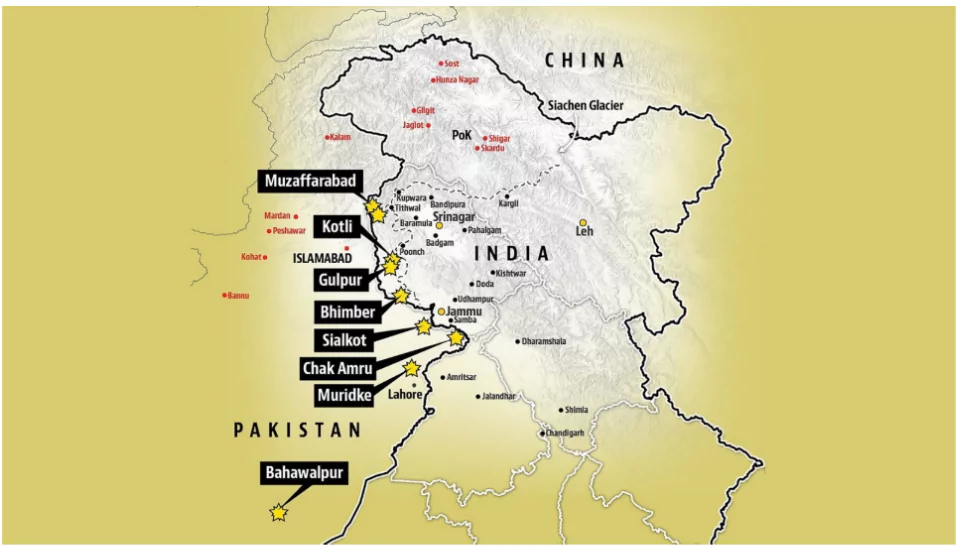Operation Sindoor showcased India’s ability to carry out precise and large-scale military operations using primarily indigenous weapons systems.
Operation Sindoor

- India launched ‘Operation Sindoor’ in response to the April 22 Pahalgam terror attack that killed 25 Indian tourists and one Nepali citizen.
- The Indian Armed Forces conducted precision strikes on nine terror infrastructure sites in Pakistan and Pakistan-occupied Kashmir (PoK).
- The targets included key terrorist hubs in Bahawalpur, Muridke (Pakistan Punjab), Muzaffarabad, and Kotli (PoK), known bases of Jaish-e-Mohammed and Lashkar-e-Taiba.
- The Ministry of Defence emphasized the strikes were “focused, measured and non-escalatory” with no Pakistani military facilities targeted.
- The operation showcased India’s strategic restraint and commitment to punishing those responsible for cross-border terrorism.
|
Operational Success as Proof of Indigenisation
- Indigenous Air Defence Supremacy: India’s Akash missile system and SAMAR short-range interceptors successfully neutralised most Pakistani drones and missiles, proving the robustness of domestic technologies.
- Pakistan’s reliance on imported systems like the Chinese HQ-9 faltered in the face of India’s superior tactical systems, many of which were developed by the DRDO and Bharat Electronics Limited (BEL).
- Role of Drones and Loitering Munitions: Operation Sindoor was also marked by the use of indigenous drones and loitering munitions that performed surgical strikes deep inside Pakistan.
- These attritable, unmanned systems reflected a shift in India’s warfare strategy, increasingly supported by local R&D and production capacities.
- Precision Strikes: The accuracy of strikes destroying specific structures within enemy compounds was possible due to India’s indigenous NavIC satellite navigation system and a suite of high-resolution imaging satellites like Cartosat and RISAT.
- These space-based assets are now a backbone for modern Indian military operations.
Indigenous Air Defence System
SAMAR Air Defence System
- Indian Air Force (IAF) had inducted the Surface to Air Missile for Assured Retaliation (SAMAR) system in 2023.
- Developed by: Indian Air Force Maintenance Command in collaboration with private firms Simran Flowtech Industries and Yamazuki Denki.
- Indigenisation Level: Medium, as it repurposes expired Russian-origin R-73 and R-27 air-to-air missiles.
- Integration, platform, and support systems are Indian.
- Key Features:
-
- Short-range (up to 12 km), road-mobile, quick-reaction air defence.
- Twin-turret launcher capable of single or salvo fire.
- Achieves Mach 2–2.5 speed.
- Designed to replace vintage Pechora systems.
- Cost-effective reuse of existing missile stockpile.
Akash Air Defence System
- The Akash air defence missile system is a medium range, surface-to-air missile system which provides area air defence against multifarious air threats.
- Developed by: DRDO; manufactured by Bharat Dynamics Ltd (BDL) and other Indian defence PSUs.
- Indigenisation Level: High with 96% Made in India content.
- Key Features:
-
- Medium-range (~25 km), all-weather, multi-target engagement capability.
- Integrated with FLR, FCC, Rajendra radar, and C4I.
- Successfully engaged 4 aerial targets simultaneously.
- Already exported to Armenia; interest from Oman, Brazil, Egypt, Philippines.
- Static deployment for IAF and Army.
Akashteer Air Defence System
- Akashteer is a next-generation Air Defence Control and Reporting System (ADCRS) for the Indian Army, enabling real-time airspace monitoring and rapid threat engagement.
- Developed by: Bharat Electronics Limited (BEL) under the ‘Atmanirbhar Bharat’ initiative.
- Indigenisation Level: Very high; fully Indian-developed system.
- Key Features:
- Automates detection, tracking, and response to aerial threats.
- Integrates Army and Air Force radars/sensors for unified air defence.
- Enables decentralised control, empowering field commanders.
- Supports systems like Akash SAM and S-400 for layered defence.
- Enhances air defence effectiveness across battle zones.
Bhargavastra Micro-Missile System
- Introduction: India’s first micro-missile-based low-cost counter-drone system, tailored to neutralise swarm drone threats.
- Developed by: Solar Defence and Aerospace Ltd (SDAL); mobile launcher platform by Economic Explosives Ltd.
- Indigenisation Level: High, fully developed by Indian firms.
- Key Features:
- Detects drones beyond 6 km; engages targets over 2.5 km.
- Simultaneous launch of over 64 guided micro-missiles.
- Proven salvo and single-fire capabilities in field trials.
- Operable across varied terrains including high-altitude zones.
- Offers economical, scalable solutions for modern aerial threats.
|
About Indigenisation of Defence Sector:
- Indigenisation of the defence sector refers to developing and producing defence equipment and technologies within the country to reduce dependence on imports.
- It enhances self-reliance, strengthens national security, promotes domestic industry, and aligns with India’s initiatives like ‘Atmanirbhar Bharat’ and Defence Acquisition Procedure (DAP) 2020.
Status of India’s Defence Sector
- India’s defence sector is poised for significant growth, fueled by indigenisation efforts and a robust order pipeline, according to a Nirmal Bang report.
- Defence production is projected to reach Rs 1.75 trillion by FY25, aiming for Rs 3 trillion by 2029.
Rise in Indigenisation of Defence Manufacturing
- Shift to Domestic Manufacturing: India now manufactures 65% of its defence equipment domestically, a major turnaround from the earlier 65–70% import dependency, reflecting growing self-reliance in defence production.
- Expanding Industrial Base: A strong ecosystem of 16 DPSUs, 430+ licensed private firms, and ~16,000 MSMEs is driving indigenous design, development, and manufacturing across defence platforms.
- Private Sector Participation:The private sector contributes 21% of total defence production, boosting innovation, efficiency, and competitiveness, with a target of ₹3 lakh crore production by 2029.
- Reducing Import: As per SIPRI reports, between 2015–19 and 2020–24, India’s arms imports declined, while defence exports surged.
- Emphasis is now on Make in India and self-reliant manufacturing
- India was the world’s top arms importer for the period 2019-23 according to the Swedish think tank, Stockholm International Peace Research Institute (SIPRI).
- Growth in Defence Exports: India’s defence exports have surged from ₹686 crore in 2013-14 to ₹23,622 crore in 2024-25 showing a 34-fold increase.
- Platforms such as the BrahMos missile, Akash SAMs, and Advanced Towed Artillery Gun System (ATAGS) have drawn interest from Southeast Asia, Africa, and West Asia.

- Private Sector Participation: Over 300 private sector firms are now part of India’s defence ecosystem. Startups are entering cutting-edge areas like loitering munitions, AI-powered surveillance, and cyber-defence.
- TATA, Larsen & Toubro, Bharat Forge, and Adani Defence are producing platforms and subsystems both for the domestic market and exports.
- Self-Reliance in Complex Platforms: India is now producing platforms that were earlier considered out of reach like the Light Combat Aircraft (Tejas), advanced radars, Unmanned Combat Aerial Vehicles (UCAVs), and anti-satellite weapons.
- DRDO’s work on Directed Energy Weapons and Deep Penetration Warheads shows readiness for next-gen warfare.
Comparison: Fighter Aircraft vs Drones (UAVs/Loitering Munitions)
| Aspect |
Fighter Aircraft (e.g., Rafale) |
Drones/UAVs (e.g., Skystriker, Harop, Heron TP) |
| Payload Capacity |
Fighter aircraft like the Rafale can carry heavy external payloads up to 9,500 kg, including multiple bombs and missiles. |
Most UAVs carry light warheads (e.g., Harop: 23 kg) suitable for precision but limited-impact strikes. |
| Cost and Attributability |
A single Rafale costs approx. $285 million, making it expensive to replace if lost. |
Drones like the Skystriker cost around $105,000, making them expendable and viable in large numbers. |
| Operational Risk |
Manned aircraft put pilots at risk, requiring high training and rescue logistics. |
UAVs eliminate pilot risk and are preferred for dangerous missions without risking human life. |
| Mission Complexity |
Fighter jets can perform complex, high-speed combat missions and navigate dynamic environments. |
Drones perform well in pre-mapped or low-complexity missions but lack dynamic decision-making. |
| Vulnerability to Defences |
Fighter jets are faster (Mach 1.8+), harder to intercept, and equipped with countermeasures. |
UAVs are slower, have lower altitudes, and are more susceptible to jamming and air defences. |
Government Initiatives to Boost Defence Manufacturing
- FDI in Defence Sector: Defence Industry sector was opened up in May 2001 for private sector participation.
- The FDI limit in the defence sector was enhanced in 2020 up to 74% through the Automatic Route for companies seeking new defence industrial license, and up to 100% through the Government Route wherever it is likely to result in access to modern technology.
- So far, Rs 5,077 crore worth of FDI has been reported by companies operating in the defence sector.
- Defence Production and Export Promotion Policy (DPEPP) 2020: DPEPP aims to achieve a turnover of ₹1.75 lakh crore in aerospace and defence goods and services by 2025, including exports of ₹35,000 crore. It mandates increased procurement from domestic sources and a focus on MSMEs.
- Positive Indigenisation Lists: Four lists, totalling over 500 items, have been notified that prohibit import of specified weapons and systems, thus mandating their domestic manufacture.
- This includes artillery guns, UAVs, radars, missiles, and communication systems.
- Innovations for Defence Excellence (iDEX): Launched in 2018, iDEX supports startups and MSMEs working on dual-use and frontier technologies.
- So far, over 250 contracts have been awarded through Defence India Startup Challenge (DISC) rounds.
- Corporatisation of OFBs: The erstwhile Ordnance Factory Board (OFBs) was split into seven corporate entities in 2021 to improve competitiveness, accountability, and export potential.
- Public-Private Partnership (PPP) Model: Increased emphasis is being placed on dual-use infrastructure through PPPs, especially in Defence Industrial Corridors (Uttar Pradesh and Tamil Nadu), allowing for the creation of shared testing, manufacturing, and R&D ecosystems.
- Selective High-Tech Imports with technology transfer: India continues to import high-end platforms, such as:
-
- S-400 air defence systems from Russia
- Rafale fighter jets from France
- MQ-9B drones from the USA
- These are often part of offset or technology transfer deals.
Significance of Defence Indigenisation
- Strategic Advantage: Indigenisation reduces dependency on foreign suppliers, ensuring uninterrupted access to critical defence technologies during conflicts and geopolitical tensions, thereby enhancing national security and strategic autonomy.
- Better Integration and Customisation: Indigenous systems allow better integration with local terrain, operational doctrines, and service-specific requirements, leading to improved battlefield performance and faster upgrades.
- Economic Benefits: Defence indigenisation stimulates domestic manufacturing, creates jobs, strengthens MSMEs, and attracts investment—contributing to the goal of achieving a ₹3 lakh crore defence production economy by 2029.
- Technological Advancement: It encourages innovation in cutting-edge areas like drones, AI-based systems, and missile technology, promoting long-term R&D and reducing the technology gap with global defence powers.
- Export and Soft Power: A robust indigenous base boosts defence exports, enhancing India’s diplomatic leverage and global stature, with exports rising to ₹23,622 crore in 2024–25 across 100+ countries.
Challenges to Full Indigenisation
- Assembly vs True Technology Ownership: Much of India’s so-called ‘indigenous’ production still involves licensed assembly of foreign-designed systems.
- True indigenisation requires ownership of core technologies design, materials, software, and IPR which is still lacking in many high-tech areas.
- Weak Military-Industrial-Academic Linkages: India lacks seamless collaboration between the armed forces, academia, and industry.
- Unlike models in Israel or the U.S., military R&D is still too centralised in DRDO, with insufficient private-sector integration.
- Bureaucratic Hurdles and Procurement Process: The current one-size-fits-all approach to trials and certification delays deployment of indigenous systems.
- Lack of realistic requirements for certification and bureaucratic hurdles often discourage private players.
- The Light Combat Aircraft (LCA) Tejas, a flagship program which showcased India’s growing self-reliance in defense technology has faced significant criticism for its sluggish pace of development, delays in production, and limited inductions into the Indian Air Force (IAF) even after more than two decades.
- Import Dependence for Input: Despite progress, India continues to rely heavily on imports for aero engines, electronics, radars, and specialised alloys. For instance, the Kaveri engine project for the Tejas jet has been stalled for decades due to technological gaps.
- Lack of Defence Startups’ Scaling: While iDEX has identified several innovative startups, funding and procurement commitments for scaling up remain weak. Many startups remain in the prototype stage without integration into national platforms.
Way Forward
- Fast-Track Certification and Trials: Certification must be realistic, performance-based, and modular. Tiered trials can be used to fast-track products based on mission requirements.
- For instance, UAVs need simpler protocols than full-scale combat aircraft.
- Real-Time Monitoring: A Defence Indigenisation Dashboard should be created to track localisation targets, project delays, and bottlenecks in real time.
- Ministries must be held accountable through quarterly performance reviews and inter-ministerial coordination.
- Technology Co-Development: India must focus on long-term joint development with OEMs under frameworks like iCET with the U.S., and Quad/I2U2 tech partnerships.
- Mere ToT (Transfer of Technology) has proven insufficient in the past but Co-development has shown promising results as in the case of Brahmos.
- Co development also provides better integration with the existing defence ecosystem. For example, the MQ-9B drone deal with the U.S. can be transformed into a co-development project with payload customization and sensor integration done in India.
- Market Leverage in Diplomacy: India’s large defence market (~$80 billion over the next decade) can be used as a bargaining chip in negotiations for IPR sharing, joint development, and export access.
- Defence diplomacy must be tied with technology acquisition, not just strategic signalling.
- Indigenisation Metrics: An Indigenisation Performance Index (IPI) must be introduced, measuring percentage of indigenous value in each procurement.
- Rankings of companies, services, and departments on the basis of IPI can create healthy competition.
- Skilling Workforce: Dedicated skilling programs in AI, robotics, aerospace engineering, and advanced materials must be scaled.
- DRDO labs, IITs, and IISc can collaborate to build a national Defence Tech Fellowship program.
- Diversifying Investment: Future wars will be hybrid, involving unmanned-unmanned teaming.
- Indigenous UCAVs, autonomous undersea vehicles, and robotic combat platforms must be prioritised.
- AI-powered ISR (Intelligence, Surveillance, Reconnaissance) tools should be integrated across all forces.
Conclusion
India’s defence transformation is based on advancing from licensed production to genuine innovation. Operation Sindoor affirms the strength of indigenous systems, but systemic reforms, faster certification, and deeper public-private synergy are essential to achieve strategic autonomy and position India as a global defence manufacturing leader.
Additional Reading: Air Defence System
![]() 15 May 2025
15 May 2025


